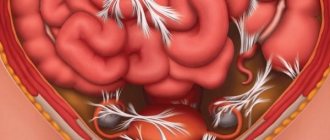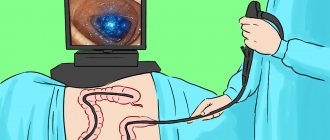Any person can encounter such a rather unpleasant phenomenon as nausea and a lump in the throat after eating, immediately after eating, and at the most inopportune moment for this: when there is no opportunity to visit a specialist who can explain why nausea, lack of appetite, weakness, a feeling as if there is a lump in the throat, what causes these symptoms and how to quickly get rid of them. For those who find themselves in a similar situation and do not know how to behave, this article will help, which lists the causes of nausea and a feeling of heaviness in the throat and provides ways to solve the problem.
- Tablets, drugs and medicines for nausea
- Alternative Treatments for Nausea
The feeling of nausea, as if sick, and discomfort in the throat is familiar to almost every second person. But if you feel nauseous and have a mild or mild sore throat only once, this is not a problem and is usually attributed to an emotional component. But if it often happens that there is weakness and a feeling of nausea, severe discomfort in the throat area, there may already be signs of both pathological and physiological causes. Further in the article we will go into detail about the possible causes of such conditions.
Causes of nausea and feeling of a lump in the throat, what may be
Heartburn, a lump in the throat, nausea and weakness can occur due to natural causes (an accidentally swallowed object stuck in the throat, pregnancy) or as a result of pathological processes occurring in the body (oncology, an inflammatory or infectious disease). Concomitant symptoms, as well as tests prescribed by a doctor based on the patient’s complaints and the results of the initial diagnosis, help determine the causes of nausea and a lump in the throat.
Reflux esophagitis
Reflux esophagitis is a chronic disease that involves the reflux of stomach contents into the esophagus, causing the latter to become inflamed and covered with small ulcers. Damage to this element of the gastrointestinal tract is indicated by symptoms such as belching and heaviness in the throat, nausea, and a burning sensation in the chest. The disease is treated by a gastroenterologist, who makes a diagnosis based on the results of an examination, including x-rays of the esophagus and stomach, gastroscopy, as well as laboratory analysis of stool and blood.
UNDER
A hiatal hernia causes internal organs to move from the abdominal cavity to the area under the ribs through a “hole” created in the wall of the esophagus. POD occurs due to excess body weight, severe coughing attacks, constant constipation, stress and is characterized by prolonged hiccups, a burning sensation and swelling in the throat, nausea, and chest pain.
Excess weight
The feeling of fullness in the throat is caused not so much by excess body weight, but by pathologies that cause excess weight: endocrine diseases, disorders of the gastrointestinal tract, diabetes mellitus. Accordingly, in order to get rid of the uncomfortable feeling, you first need to identify the causes of nausea and nausea, then undergo a course of treatment for the underlying disease and bring your weight back to normal - only in this case can you count on improving your well-being.
Thyroid pathologies
An unpleasant feeling in the throat may be due to a pathological condition or malfunction of the thyroid gland. A doctor specializing in this area - an endocrinologist - will help determine whether this is so. If the fears are confirmed, you will need to undergo a course of treatment with special drugs or resort to invasive intervention that will solve the problem in a radical way.
Diseases of the nasopharynx
An inflammatory, purulent or purulent-inflammatory process in the oral or nasal cavity can have different origins - it can be a consequence of a disease of the gastrointestinal tract, a bacterial or viral infection, problems with the gums or teeth. Only specialists - an otolaryngologist, a dentist and a gastroenterologist - can determine the exact cause of the ailment, expressed in the form of a lump in the throat, nausea, chest pain.
Oncology
The sensation of a foreign object stuck in the throat can cause a tumor of the lung, larynx, esophagus or stomach. If a person does not ignore this sensation and goes to a medical facility, the formation will be detected at an early stage and appropriate therapy will be carried out, which will significantly increase the chances of a full recovery.
Allergic reaction
Nausea, hiccups and a lump in the throat are common complaints among people suffering from allergies. Various substances can provoke an inadequate response of the human immune system: pollen or plant sap, animal hair or saliva, certain chemical compounds, mold, mildew, and even cold or water! Allergy treatment involves identifying all possible “provocateurs”, determining the degree of their impact on the body and prescribing specific medications based on the information received.
Psychological factor
Often the cause of a lump in the throat is a psychosomatic factor. Psychosomatics refers to the relationship between the psychological and physical state of a person. Strong emotional experiences trigger a series of processes in the body that lead to the development of various pathologies and diseases - primarily, diseases of the gastrointestinal tract, which, as is known, make themselves felt through symptoms such as nausea and bad breath, vomiting after nausea, burning sensation in the esophagus, pain in the epigastric region.
Spinal diseases
A discomfort in the throat can be caused by a curvature of the spinal column, the presence of a herniated disc, displacement of the vertebrae, or degeneration of the intervertebral discs. To exclude this possibility, it is necessary to undergo an MRI and show the finished results to a neurologist.
Having bad habits
A feeling of fullness in the esophagus, aversion to food and nausea, a feeling of heaviness in the throat may appear after drinking alcohol or smoking. Tobacco and alcohol cause serious damage to the mucous membrane of the digestive tract - under their influence it becomes inflamed and covered with deep ulcers. If you constantly or periodically have a sore throat, you need to give up bad habits for a while, or best of all, forever - your health will immediately improve.
Foreign body
Sometimes a person’s senses do not let him down, and a foreign object is actually found in the esophagus - a fish bone, a piece of a fibrous product, or an accidentally swallowed inedible object, which is clearly visible on an x-ray. In this case, the feeling of fullness disappears immediately after removal of the foreign body, which is carried out under local or general anesthesia.
Parasitic infestation
It is commonly believed that parasites live exclusively in the intestines, but this is not so. Their larvae are able to migrate inside tissues, so they can be found in any part of the body. If you feel sick and feel a lump in your throat, your stomach hurts and you feel sick after eating, your body may be infected with helminths. If this is the reason, you should not waste time thinking about why there is a heaviness in the stomach, a lump in the throat and nausea, what it could be - you need to immediately take a stool test for worm eggs. If he identifies parasites, it will be necessary to undergo deworming - if this is not done, a lump of parasites can block the lumen of the esophagus, thereby causing death from suffocation.
Lump in throat nausea dizziness weakness symptoms
In domestic medicine, osteochondrosis refers to degenerative processes that occur in the intervertebral discs, directly in the vertebrae and small joints of the spine.
Due to a sedentary lifestyle, excess weight, and neglect of sports, this disease has made people much younger. Teenagers who prefer computers and TV to outdoor walks are at risk.
They gradually develop poor posture, the back muscles become weak and symptoms of osteochondrosis appear.
Cough with osteochondrosis
Cough with osteochondrosis occurs during dystrophic changes in the cervical and thoracic region of the spine. In these areas, nerve roots and vessels of the circulatory system are concentrated, which connect the spine with the brain and all internal organs.
Read: Reviews about the trench collar for cervical osteochondrosis
If during a cough the patient feels pain in the neck or back, then you need to see a doctor for examination.
With osteochondrosis, pinching of six thoracic roots is observed. This causes pain and discomfort in the throat. Which, in turn, makes a person cough.
Coughing during illness increases compression of the artery in the spine. It supplies blood to the brain and spinal cord. Impaired blood supply leads to lung problems, which causes cough and one-sided sore throat. This clinical picture resembles a sore throat. If the pathology is not treated, the cough becomes permanent and intensifies at night.
At the beginning of the disease, the cough is dry and paroxysmal. It occurs when bending over, turning sharply, and also after sleep. Over time, the nervous system malfunctions, the blood vessels do not fully nourish the lungs, and the cough becomes wet and hoarseness appears in the voice.
To identify the cause of the cough, you need to consult a doctor. The first step is to examine the patient's respiratory system. If no deviations are detected, then an additional examination will be prescribed:
- X-ray of the spine;
- MRI or CT;
- myelography;
- contrasting discography.
The results of the examination will help make the correct diagnosis and prescribe appropriate treatment.
Edema with osteochondrosis
With cervical osteochondrosis, patients experience swelling of the facial part of the head, sometimes it spreads throughout the body. Edema is formed due to compression of blood vessels. The process of squeezing provokes the formation of congestion in the veins. Stagnation deforms the tissue, that is, swelling occurs. If this symptom is detected, consultation with a neurologist is required.
Treatment of edema:
- Massage. This method improves blood circulation in tissues and perfectly relieves tension.
- Acupuncture. It has a comprehensive effect on the disease and removes almost all symptoms.
- Medicines. Diuretin removes tissue swelling.
- Physiotherapy. This technique improves the general condition of a person.
Read: How to sleep with cervical osteochondrosis
If the underlying disease is not treated, swelling may appear again and again.
Nausea with osteochondrosis
Patients diagnosed with osteochondrosis often experience bouts of nausea in the morning. Neurologists note that treating only this symptom of the disease is useless. With a targeted effect on osteochondrosis, nausea will go away on its own, as the blood supply to the brain will be restored.
In case of a severe attack of nausea, it is recommended to perform a local massage, as well as exercises to restore microcirculation of the brain vessels of the head.
Exercises to eliminate nausea:
- The person is sitting or standing. Place the palm on the forehead and press on the frontal area for 10 seconds. Perform 5 to 7 times.
- Place your palm on your cheek and press for 10 seconds. Perform up to 7 times.
- It's comfortable to sit down. Cross your arms over your chest. Take a deep breath and lean to the side, then exhale and come back.
Osteopaths recommend that patients with bouts of nausea reconsider their diet. It should be as correct as possible, reduce salt intake, and eliminate caffeinated drinks. With such symptoms, you cannot use medications that contain aspirin.
Weakness due to osteochondrosis
Spinal pathology is characterized by displacement of discs and partial destruction of the cartilage between them. As a result, protusions and hernias are formed. In this condition, blood vessels are compressed and nerve endings are pinched. The entire body begins to experience oxygen starvation, the functioning of internal organs is disrupted.
Read: Massage of the collar area for osteochondrosis
These phenomena lead to the patient feeling weak and not having the strength to do anything. Neurologists note that the patient feels weak when the disease is in an advanced form and treatment began late.
The symptom of weakness shows in which part of the spine osteochondrosis has developed. If a person has weakness in the arms, then the cervical or thoracic region is affected. Weakness in the legs indicates pathology in the lumbar region, and weakness of the back muscles is considered a symptom of osteochondrosis of the thoracic region.
Weakness in the body is felt in the morning, but can increase during the day along with physical activity.
Lump in throat with osteochondrosis
Due to changes in the spinal column with osteochondrosis, a person feels the presence of a lump in the throat. The pathology is located in the cervical region, where there is a displacement of the discs to one side or the other. If the disease affects the fourth cervical segment, then negative consequences appear on the pharyngeal muscles and the patient feels a lump in the throat.
A person experiences these unpleasant sensations all the time, especially at night. Some people have a fear of suffocation or choking. All this leads to depression and nervousness.
A lump in the throat with osteochondrosis is combined with symptoms:
- numbness;
- limitation of range of motion;
- decreased sensitivity.
Read: A set of exercises for thoracic osteochondrosis
Treatment of a lump in the throat with osteochondrosis involves:
- use of ointments and gels;
- physiotherapeutic measures;
- Exercise therapy and massage;
- acupuncture.
Complex treatment of osteochondrosis of the spinal column helps eliminate all symptoms of the disease. This significantly improves a person's quality of life. Be sure to coordinate the treatment of osteochondrosis with your doctor.
SUBSCRIBE TO SITE UPDATES
Source: https://novosibmemorial.ru/kom-v-gorle-toshnota-golovokruzhenie-slabost-simptomy/
When to Seek Help from a Doctor
If you are coughing and feel like there is a lump in your throat, but your health returns to normal within 24 hours, there is no reason to worry. It makes sense to consult a doctor when, along with a lump in the throat, there are symptoms such as weakness and nausea, fever, dizziness, pain in the abdomen, chest and/or throat, upset bowel movements, or if you have been feeling sick for a long time and severely , then vomiting, after vomiting there is a feeling of something extra in the throat, and this feeling does not go away.
Diagnostics, how to correctly determine the cause
Patients who complain of a feeling of fullness in the esophagus are usually asked to undergo an examination, including:
1 blood, urine and stool test;
2 laryngoscopy;
3 radiography;
4 CT, MRI;
5 gastroscopy;
6 Ultrasound of the thyroid gland and abdominal organs.
The primary examination of the patient is carried out by a therapist, who also decides to involve specialized specialists in the examination.
Mechanisms of occurrence
The mechanisms behind the appearance of a lump in the throat vary from person to person. Most often they are associated with the reason due to which this symptom appeared. The essence of the development of such a pathology can be reduced to spasm of the larynx, the presence of a foreign body, inflammatory processes, edema, etc.
Causes
At first glance, the appearance of a lump in the throat may not seem to be a serious problem, especially since this condition is temporary and does not always cause severe discomfort to a person. However, this opinion is wrong.
There can be many reasons for the occurrence of this symptom - from stress to serious cancer.
Let's take a closer look.
Relux esophagitis
One of the most common reasons. Reflux esophagitis is a chronic disease of the gastrointestinal tract, which consists of pathological reflux of stomach contents back into the esophagus. As a result of exposure to bile and other acids, inflammation of the stomach walls occurs and a number of characteristic manifestations occur: abdominal pain, heartburn, belching, and indigestion. Patients with reflux esophagitis often complain of a lump in their throat and say they feel nauseous. The disease is diagnosed by a gastroenterologist based on complaints, examination and additional diagnostic methods (x-ray of the esophagus and stomach with a contrast agent, gastroscopy, stool and blood tests).
Esophageal hernia
In medicine, it is also called a hiatal hernia or HH. The disease is characterized by the displacement of organs from the abdominal cavity to the thoracic part through a natural or pathological opening in the diaphragm of the esophagus. A hernia can develop due to prolonged coughing attacks, frequent constipation, excess weight, and prolonged emotional overload. Often accompanied by prolonged hiccups, heartburn, and pain in the chest area. With a hernia, a lump appears in the throat and mild nausea.
For those who suspect they have a hernia, watch the video
Excess weight
The culprit in this case is not the presence of excess weight, but the conditions that the gained “extra” kilograms can lead to. The disease can occur due to frequent overeating, poor nutrition, and indulgence in sweets and flour products. Excess weight can also lead to disruption of the endocrine system and gastrointestinal tract, which will lead to a number of unpleasant symptoms and a lump in the throat.
How to treat a feeling of a lump in the throat and nausea
To get rid of discomfort, you first need to identify the causes of nausea and a lump in the throat. To do this, you need to undergo an examination in a hospital and go to a therapist with ready results.
Tablets, drugs and medicines for nausea
Getting rid of the feeling of fullness caused by the disease is carried out with the help of appropriate medications:
1 antiulcer, adsorbent, antispasmodic agents;
2 antiparasitic drugs;
3 sedatives or antidepressants;
4 hormonal drugs.
Standard prescriptions for complaints of a lump in the throat include taking the following medications:
1 Nolpaza (neutralizes hydrochloric acid, thereby helping to normalize the digestive process and eliminate reflux).
2 Persen (relieves the feeling of fullness in the esophagus caused by stress, helps cope with mental and emotional overload, insomnia, and increased aggressiveness).
3 Iodomarin (normalizes the functioning of the thyroid gland by replenishing iodine deficiency in the body).
4 Laripront (helps to cope with the feeling of fullness in the throat that occurs against the background of an inflammatory or infectious oral disease).
5 Motilium (an antiemetic that relieves discomfort in the esophagus caused by esophagitis or gastroesophageal reflux).
What can you do at home if you feel nauseous and feel like there is a lump in your throat?
If there is a lump in your throat and you want to vomit, but there are no medications at hand, you can resort to the help of traditional medicine. The main thing is to make sure that there is no allergy to the “medicine” before starting treatment. A skin test will help with this, involving applying a small amount of the finished product to the wrist or bend of the elbow. The absence of redness and itching indicates that the substance used is safe, which means there is no need to be afraid of the development of unwanted complications in the form of dermatitis, urticaria or Quincke's edema.
Soothing tea
This remedy, which has a mild sedative effect, is prepared as follows: one teaspoon of classic green tea without adding flavorings is mixed with the same amount of valerian, St. John's wort and peppermint, pour the mixture into a teapot and pour boiling water over it. The finished collection is taken throughout the day at regular intervals.
Sea water
If you have a sore throat and feel a lump in the esophagus, you can resort to rinsing your mouth with a solution prepared from a third of a teaspoon of regular table salt, a pinch of sodium bicarbonate and a couple of drops of iodine dissolved in a glass of water.
Beet juice
Sea water dries out the mucous membranes, so it is used to gargle the throat when mucus flows down its wall. If your throat tickles and you feel nauseous, but no mucus is observed, replace the sea water with beetroot juice diluted with water at the rate of two tablespoons of extract per glass of water.
Chamomile decoction
If the feeling of fullness is a consequence of the inflammatory process, a decoction made by brewing one filter bag of chamomile with two glasses of boiling water will help eliminate it.
Meadowsweet infusion
If you often feel sick and the heaviness in the throat does not go away, you can resort to meadowsweet infusion. It is prepared as follows: crushed roots in an amount equal to one hundred grams are poured with half a liter of vodka and the container is put in a dark place for two weeks. The expressed infusion is taken one teaspoon three times a day half an hour before meals.










